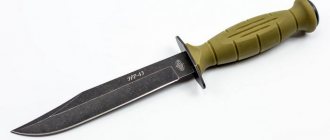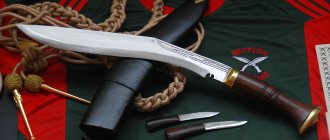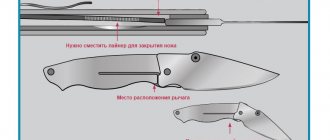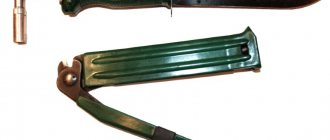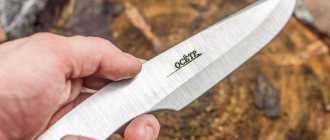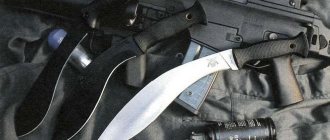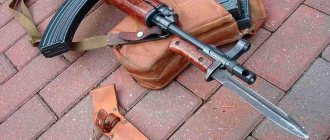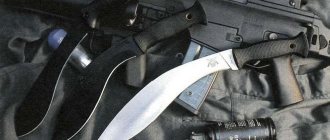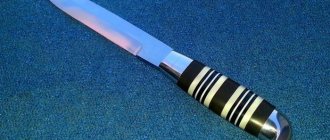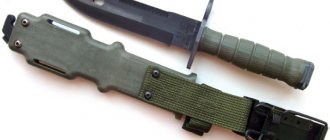The traditional ancient type of bladed weapon of the peoples inhabiting the mountainous country of Nepal has a unique name - Kukri (khukuri, khukuri). These are heavy, massive, durable, well-balanced knives that can be used in close combat, making paths and building huts. In everyday life, they can be called anything: cutlasses, machetes, knives and even short swords.
Weapon Description
High carbon steel is used to produce a combat knife. The kukri has a curved blade, the configuration of which is called the “falcon wing”. The butt has an inclination angle from 20 to 40 º. The Nepalese kukri knife is sharpened only on the inside. The lower part of the blade is widened, so its center of gravity is located at the tip. This shape is convenient for slashing attacks. Combat army knives are 15 inches long and weigh 600 grams.
The features of this ancient weapon have a deep sacred meaning. They are as follows:
- The blade has zone hardening, hard in the blade area and softer near the butt.
- On both sides of the butt there are longitudinal grooves - valleys or lobes. They are called "swords of Shiva." Legends say that they give the weapon magical properties, and also improve the rigidity and shock absorption of the blade.
- The cross-section of the blade has a triangular shape, which personifies the trinity of the gods Vishnu, Shiva and Brahma.
- The blade is sharpened at different angles, which allows the kukri to be used not only for combat, but also for economic purposes. This sharpening represents the Sun and Moon - sacred Nepalese symbols.
- Near the handle there is a recess called “cho”, which can have different shapes. This is either the “trident of Shiva” - the main symbol of the deity, or the “trace of a cow” - an attribute of the goddess of death Kali. The notch is designed to reduce stress on the blade during operation and prevent chipping.
- The handle of the kukri is made from buffalo horn. There are rings on it that have a sacred meaning - these are symbols of the universe. They serve to prevent the weapon from slipping out of your hand.
- The handle is equipped with a steel or brass pommel. It is called the “eye of God” and is used for hammering nails or cracking nuts.
- The thickness of the butt is 12 mm, thanks to which the curved knife acquires enormous power. The Kukri delivers excellent slashing attacks, although cutting blows are not as effective.
Design features. Exposing the khukri.
Varieties of "cho" khukri
Now, as for the little things. Khukris, starting from the nineteenth century, have a figured cutout on the heel of the blade, near the hilt. This cutout is called “cho” - “cho” or “kaudi” - “coady”. Initially, it was a simple sampling of the blade’s metal, separating the sharpened part of the blade from the heel or ricasso itself. Subsequently, this khukri detail underwent modifications and received a more complex shape with a tooth or even several in the middle of the notch. There are a considerable number of versions about the purpose of this element in the design of the khukri, some of which are unlikely and even somewhat fantastic. For example, one opinion says that this is a kind of device for gripping an enemy’s blade, another version is an element that prevents the flow of blood onto the handle or even a lock for fixing it in the sheath... In short, we won’t list everything, but will go through more convincing versions. One of them is an increase in fracture resistance in the area of the heel of the blade, with a strong chopping blow. The version, of course, has a right to life, but from the point of view of physics, it is unconvincing. Perhaps the selection of metal reduces the likelihood of fracture, but not by an order of magnitude, and that is due to the shock-absorbing properties acquired by the blade with such a design. But the most common and quite logical explanation for the cutout on the khukri says that the shape of the kudi allows one to determine in which region and in which workshop the khukri was made
.
Perhaps the shape of this element is a kind of signature of the master or his guarantee.
Zone hardening of the Khukri blade
The simplest khukri (kukri) were usually carved with a primitive “kodi” or “cho”, whichever is closer to you, and, perhaps, they were made by apprentices who did not yet have their own sign. But with the advent of factory production of these Nepalese bladed weapons and souvenir khukris for tourists, - Kodi
became schematically simple, and finally lost all its semantic meaning. It was then that versions of the necessity and significance of this element in the design of the khukri began to grow by leaps and bounds. Although, in the same way one can dismiss the religious component in the design of this traditional Nepalese weapon. In general, how many people, so many opinions. There is no official data on this matter, and there will not be, but the debate on this issue will never subside.
Doly on khukri
The next element present in the khukri (kukri) blade is the dol. Doly
- there is a longitudinal selection of metal, starting from the handle and going to that part of the butt of the blade where its gradual thinning begins. There are also many versions here, but luckily the theory of strength of materials comes to our aid here. So, according to one of the theories of the mechanics of a solid deformable body, the selection of metal in the thickest part of the product reduces its mass, without reducing the strength, and thereby shifts the center of mass further towards the end of the blade.
Handle installation method
Khukri handles
Khukri handle with stamp
Let's move on to the handle. Handles
they were made of wood or bone and mounted through a steel bolster onto the shank of the blade, previously lubricated with a mixture of hot organic resin and dust or sawdust, which served as a kind of glue. This method of attaching the handle was considered preferable, since it made it possible to repair or replace the handle, easily dismantle it by heating it to 100 o C and put a new one in its place.
Step-by-step instructions for making Kukri
Detailed instructions are required to understand the sequence of actions. If you follow this algorithm, you will get a predictable result:
- Apply the pattern to the selected piece of material. We make an overlap along the contour of 5 mm, this allows you to later file all the edges and get the desired size.
- The outline is drawn with a sharp tool, preferably with an ebonite tip.
- A piece is cut out along the outlined contour. You can use a grinder.
- The ingot is heated over high heat and hammered with a 3 kg hammer. In this way the blade and shank are formed. The process takes about 30 minutes, so it's best to do it together.
- During this time, the metal will cool and darken. It's time to reheat and hammer 1.5 kg. During the work process, it is advisable to constantly change surfaces so that the processing occurs evenly.
- The dol is formed from a metal rod. It is pressed against the blade blank and beaten with a light hammer.
- Water is poured onto the hot blade of the almost finished product. It should be cold and place a thin thread on the metal strip along the cutting edge. This is how zone hardening occurs: the workpiece is periodically heated and doused with cold water.
- The resulting piece is processed with a file and sanded with fine sandpaper. The polishing process is carried out using genuine leather.
- The handle is made of wood and is attached to a rod, fixed with glue.
- A metal cap is placed on the end of the handle, which is secured to the rod with a nut.
Kukri knife.
Blade sharpening
Cleaver knives and machetes are distinguished by the presence of a durable, sharp blade. However, the nature of sharpening this tool depends entirely on the needs of the master. Getting the smoothest, cleanest cutting edge possible will definitely take extra time, since it is not so easy to make a sharp machete. The knife is made of steel, and working with this material is not easy.
To make the task easier, handing over a homemade tool to a professional blacksmith for processing. However, sometimes it turns out to be easier and faster to handle the matter yourself than to resort to outside help.
If a good result is considered to be a sharpening that is not inferior to the sharpening of kitchen knives, then you can process the blade on the same grinding machine. The tip can be made more pliable by heating it with a propane torch. At the same time, in order to avoid overheating, it is advisable to periodically immerse the machete blank in cold water.
The knife, or rather its blades, is processed with the most affordable sharpening tools, which can be purchased at any hardware store.
It is better to make the blade moderately sharp and use the tool only for solving everyday problems. Having made a machete combat knife, it is not recommended to carry it with you or carry it in a car, since the tool may be regarded by law enforcement agencies as an illegal bladed weapon.
Tools
To make a machete at home, you will need the following set of tools:
- whetstone or grinding wheel;
- Bulgarian;
- sandpaper;
- gypsy needle or awl;
- hammer;
- vice;
- roulette;
- container with water;
- protective glasses.
To choose a suitable design, just look at several ready-made machetes and photos of knives in a tourist store. Initially, it is better to draw on paper a couple of the most suitable sketches, so that later you can choose a single option, the parameters of which correspond to the possibilities of manufacturing the product using available materials. As an example, you can pay attention to kukri machete knives, the blade of which has an impressive width along the entire plane and noticeably narrows only in the area of the handle.
Sacred meaning of kukri for Gurkhas
Each unusual element of a Nepalese combat knife has its own meaning. For example, the triangular shape of the blade's cross-section represents the three gods of Hinduism. In addition, other weapon elements indicate the following:
- The blade itself, which has different sharpening angles, symbolizes the sun and moon;
- The metal recess near the handle symbolizes the trident of the god Shiva, which in India is considered a symbol of power. This notch is called “cho” and can also have the shape of a cow’s footprint. In this case, she symbolizes the goddess Kali;
- The top of the handle is called the “eye of God.” It should help the owner of the weapon in battle.
You need to know that modern kukri models, which are sold in local Nepalese shops, are not always made in accordance with sacred rules. For this reason, for a tourist who wants to touch a real legend, it is very important to examine the knife to ensure that all the necessary design elements are present. As for advice on choosing, the metal for knives is ordinary spring steel, and local craftsmen often save on shanks.
Now there are models that have an all-metal handle, with wood or horn overlays. These are not identical knives, but they are much more reliable. The kukri sheath has compartments to accommodate two additional knives. One of them is a working tool intended for work, and the second is used for editing. This knife will not help you fully sharpen the blade of your kukri, but it will cope with straightening out minor kinks.
Traditions that influenced the design of the khukri.
Today there are a wide variety of varieties of khukri. Also today, khukri
has become so popular that many manufacturers, mainly from the USA and Germany, produce modern replicas of this legendary weapon. Among the varieties we can note:
- Ang-khola
- Chitlang
- Panaval
- Sirupati
- Ganjaola
Basically, the diversity of khukri is due to the fact that Nepalese blacksmiths from various families passed on their traditional forms and manufacturing secrets from generation to generation.
Varieties of khukri
Khukri with scabbard
Auxiliary Tools
Thanks to the unique design, the khukri can chop, cut, and act as a hammer. Balancing the blade allows you to throw khukri over short distances. Let's look at the design of the classic traditional khukri shown in the figure.
Essential elements:
- Curved blade, sharpened on the inside
. The khukri is sharpened in a v-shape, at a large angle, which provides maximum effect when chopping. The average blade length is thirty centimeters, with a total length of forty to forty-five centimeters. The total weight is usually no more than seven hundred and fifty grams, and the center of gravity is shifted closer to the tip and further from the handle, by about eight centimeters. All this allows you to deliver powerful slashing blows, using all the inertial force of the weapon upon impact.
- Handle characteristic of a khukri
. The rings on the handle have a double meaning. On the practical side, the rings (7) prevent the weapon from slipping out of the hand, even if the hand or handle is wet. In addition, the rings serve as a symbol of the levels of the universe. - A groove or several grooves near the butt
.
Has practical and symbolic meaning. The practical significance is not blood flow, as many mistakenly believe, but a kind of shock absorber to increase the shock-absorbing qualities of a weapon when hit with a butt. This same groove is called the “ Sword of Shiva
” and, according to legend, gives the khukri the power of the weapon of the God of destruction - Shiva. - The variable-angle blade
provides maximum efficiency in all types of strikes, and also symbolizes the Sun and Moon, which are the traditional symbols of Nepal. - A special notch on the blade near the handle
also has a double meaning and is called “
cho
”.
The shape of “cho” can be different, the diagram shows the classic form, and it also comes in the form of a “cow footprint”. From a symbolic point of view, "cho" of the classical form means the trident of Shiva
, as the main attribute of the symbol of the power of the God of destruction.
If “cho” has the shape of a “ cow footprint
,” then this is a symbol of the Goddess Kali, and the cow footprint itself belongs to an animal sacred in Hinduism.
The practical meaning of “ cho
” is no less profound. This notch prevents the formation of cracks that lead to the blade chipping at the handle upon impact. That is why most American versions of khukri produced today and not having this seemingly primitive attribute often break when hit in the area of the handle. - The metal plate on the pommel of the handle
is a symbol of the all-seeing eye of God, and in practice it covers the end of the blade tang, which passes through the entire handle.
Traditional khukri has not only variable sharpening angles, but also zone hardening. The blade is softer at the butt and gains hardness as it approaches the blade. Usually the hardness values are as follows: on the butt - 48-57HRC, closer to the edge of the blade it reaches 60-62HRC. The features of traditional forging, passed down from generation to generation, make it possible to maintain the elasticity of the blade despite such hardness. The blade itself is forged by hand from high-quality spring steel.
Khukri
Khukri with scabbard
Khukri with scabbard
Modern khukri production uses
1095
and
5160
spring steel . The raw materials are springs from heavy trucks and buses, then from German cars, and then from the Japanese automobile industry.
Handles for khukri
traditionally made from rosewood or water buffalo horn. The handles can be decorated with carvings, various symbols or images of deities. All this gives the khukri even more power in terms of magic.
In addition to the main blade, the scabbard, usually made of leather and trimmed with metal or brass, also contains two small auxiliary tools. They are called carda
- used for small work, and
hakma
or
chakmak
is simply a piece of steel that serves as
a musat
, for straightening a cutting edge,
pile
or
chair
.
General purpose
Actors of the film Apocalypse Now
A standard set aimed at solving the most common tasks in the kitchen. The kit includes:
- The chef's knife (German, French) is a real all-rounder with a curved blade and impressive weight. The wide and heavy blade copes with both chopping bone and chopping greenery with equal success. And faster cutting of vegetables without extra effort is ensured by the shape of the cutting edge, thanks to which the tool can be swung without lifting it from the board. The popular size is 20 cm, but there are also specimens from 15 to 30 cm long.
- A paring knife with a straight or claw-like blade. Thanks to its modest size (6–10 cm), it is ideal for small or complex work. The small blade is equally convenient when peeling vegetables and fruits, as well as when peeling shrimp or decoratively cutting food.
- A utility knife is an auxiliary tool that often makes professional cooks smile. This product occupies an intermediate niche between the two above-mentioned varieties. It is too light to perform the tasks that a German chef can handle (chopping, grinding bones). At the same time, a long (10–18 cm) blade is not suitable for cleaning or neat figurative work.
- A bread knife is a blade with a serrated blade. The characteristic shape allows you to cut neat slices without crushing the soft loaf or crumbling the hard one. Length from 15 to 25 cm.
- A butter knife, which is commonly considered a serving cutlery. Meanwhile, it is difficult to imagine making sandwiches without this tool with a wide and flexible blade. The blade with a rounded tip and a blunt (sometimes wavy) edge does an excellent job of evenly distributing soft cheese, jam, butter, mayonnaise and similar products across a slice of bread.
Elements of a kukri knife
All knives have a blade and a handle. But each has its own differences and characteristics.
Kukri Blade:
- The downward curve is not the only feature. The blade has a triangular cross-section.
- An interesting solution is that the hardening of the blade has different values; the cutting edge has a higher value than the value closer to the butt.
- Sharpening is done only from the inside, but it is with a variable angle. This allows the knife to be used for stabbing, chopping, and cutting. Kukri is a universal instrument.
- There is a dol on the blade. Experts say that it is made to improve shock absorption during slashing or blows with a butt.
- There is a notch made near the handle, it is called cho. It comes in different forms, but the essence is the same. The function of this is to protect the blade from chipping. Similar knives without cho, manufactured on the American continent, break at the handle when chopping on hard material.
- The material used to make the handle is water buffalo horn or rosewood. Rings are made on it for better fixation in the hand. Even a wet hand does not slip.
- The metal cap at the end of the handle allows it to be used as a hammer.
Kukri: design.
Why is Shiva's tooth on a knife?
In Nepal, it is believed that if a kukri is taken out, it should be stained with blood. This belief kept its owner from taking rash steps. Shiva's tooth served to prick the finger and lubricate the blade with blood before sheathing it.
Is it foldable?
Folding kukri is used as a souvenir, during hiking or fishing as a handy tool. In this case, the blade is made entirely of high-carbon steel and the ratio of the length of the blade to the handle is non-classical. It cannot be used as a military weapon.
Possession technique
The knife can be held with both hands or with one. The hand with the knife is slightly raised and pulled back. The grip is made with the entire palm on top of the handle, as close to the blade as possible. All this is due to the fact that the blows with this knife are chopping.
Blows can also be delivered with a handle that ends in a metal cap. Each kukri owner has an individual technique for owning it. In Nepal, no one was specifically developing it.
Plastic scabbard
Plastic sheaths are less difficult to make than wooden sheaths. The following materials and tools will be required:
- saw and drill;
- plastic pipe;
- construction hair dryer;
- leather fastening for sheath;
- sandpaper;
- pencil;
- drill with a thin drill bit;
- bartacks and riveter.
Read also: Making labels for clothes
Initially, you need to create a basic blank from a plastic pipe. Cut a piece 2 cm larger than the knife blade with a part of the handle that will be recessed in the sheath. Cut the pipe in half lengthwise. Heat it with a hairdryer at +400 degrees, wearing protective gloves. As the pipe softens, insert a knife and shape the plastic to resemble the tool itself.
Then let the plastic cool and become hard. Use a file to saw off excess parts of the material along the length and width. Use a pencil to mark where the rivets will be inserted. Drill holes with a drill, attach the leather parts with rivets, securing them with a riveter. If necessary, you can paint the sheath in any color with plastic paint. This will make them easier to find in the grass if they fall. It’s not difficult to build a sheath, the main thing is to be careful and follow the correct sequence of actions, then you can save a lot on your purchase.
Housewives in the kitchen, as a rule, have wooden or plastic knife stands. When stored, they do not get dull on kitchen utensils. Knives that are used outside the home do not have these privileges: when traveling, going out into nature, fishing, hunting. This problem can be easily solved if you make a knife sheath with your own hands. In this case, there is no need to go shopping, and you can make such a holster according to your preferences.
Advantages and disadvantages of Nepalese kukri
Nepalese kukri has the following advantages:
- heavy blade;
- delivers perfect slashes;
- can also be used for some household work;
- Suitable for striking with a pommel.
But this type of knife also has its disadvantages:
- centering located closer to the tip - the knife is uncomfortable to hold in the hand;
- the presence of notches/rings on the handle – the palm rubs until it bleeds, subsequently the skin becomes rough;
- it is impossible to apply cutting blows;
- You can’t use kukri in the kitchen - you won’t even be able to cut meat, fish, or peel vegetables.
Why is kukri needed in peacetime?
Daggers with a concave blade are famous for their versatility, therefore they are widely used in everyday life. In Nepal, curved blades are still used as an axe. Trim vines and bamboo stems.
Travel knives
If you want the familiar blade from the movie Flint, go to a specialty store. For home use, a variety of Nepalese kukri-bhojpura is suitable. The Angola, a heavier model of a camping knife, is useful for trimming bushes.
The original blade can be ordered from local craftsmen. Discover models with durable metal handles covered in wood or bone.
Knives for hunting, fishing and mushroom picking
Models made from modern materials that imitate kukri are an excellent choice for hunting or fishing. Curved blades are equally effective as mushroom picking tools.
The universal properties of the knife will allow you to light a fire, build a hut, and divide meat and vegetables. For long trips, modern stores offer sets of kukri knives with sheaths. The set consists of three products: one of the additional knives is used as a working tool, the other is used for sharpening in the field.
There are several types of curved blades, they differ in weight, size and angle of the stock. Universal models are available weighing from 400 to 900 g. Length from 20 to 35 cm. Shifting the scale closer to the tip of the blade allows you to strike and cut by inertia, and not by your own efforts.
Pirat and Viking Nordway copies are suitable for household needs. For a special connoisseur - products of the Cold Steel brand. Industrial designs are produced without the Shiva pole.
The price of kukri blades depends on many parameters and ranges from 2 to 50 thousand rubles.
Varieties of kukri-machete
The Kukri is often called the Nepalese machete because the weapon comes in several types and most often has the shape of a large chopping instrument. The most famous types are:
- Hanshi - refers exclusively to utility knives, used as a sickle;
- Catrimoras - richly decorated weapons, used as souvenirs;
- Bhojpuri/Ang Khola - intended for farming, has an average blade thickness of 10 mm;
- Janavar katne - the blade is thin and long, very similar to a traditional sword;
- Sirupati - produced only in the south of Nepal, considered the narrowest knife;
- Badhum - characterized by a thick and short blade with a large width;
- Bunspati is a true combat weapon with a narrow blade.
Varieties of kukri
Story
Colonel Gambhir Singh Rayamajhi Kshetri, Gorkhali Commander armed with a Khukuri in his left hand and a Talwar to his right.
Chief Minister of Gorkhali (Kaji) and Army Commander Kalu Pande with khukuri on his chest.
Researchers trace the origins of the blade to a household sickle and a prehistoric curved stick that was used for hunting and later in hand-to-hand combat. Similar implements existed in several forms throughout the Indian subcontinent and were used as weapons and tools, for example in sacrificial rituals. Burton (1884) writes that there was a large kukri-like falchion inscribed in Pali in the British Museum. Among the oldest kukris are those belonging to Drabya Shah (c. 1559) and preserved in the National Museum of Nepal in Kathmandu.
The Kukris became known to the Western world when the East India Company came into conflict with the growing Gorkha Kingdom, culminating in the Gurkha War of 1814–1816
It received literary attention in the 1897 novel Dracula by Irish writer Bram Stoker. Despite the popular image of Dracula being staked through his heart at the end of the climactic battle between Dracula's bodyguards and the heroes, Mina's narrative describes his throat being slit by Jonathan Harker's kukri and his heart being pierced by Quincy Morris's Bowie knife.
All Gurkha troops are issued two kukris: Service No. 1 (ceremonial) and Service No. 2 (exercise); in modern times, members of the Gurkha Brigade are trained in its use. The weapon came to prominence during the Gurkha War, and its continued use during the First and Second World Wars enhanced its reputation among both Allied and enemy forces. His recognition was demonstrated in North Africa by a unit situation report. It reads: “Enemy losses: ten killed, ours zero. Ammunition consumption is zero."
On 2 September 2010, Bishnu Shrestha, a retired Indian Gurkha Army soldier, alone and armed only with a khukri, defeated thirty bandits who attacked the passenger train he was on in India. He reportedly killed three bandits, wounded eight more and forced the remaining bandits to flee. Recent report in Times of India
, which includes an interview with Shrestha, indicates that he was less successful.
Case
At the end of the work, you should take care of making a convenient case, the presence of which will contribute to the safe operation of the product. Cut out a case in which the machete will be placed - the knife is large enough and sharp, you can use it from a piece of thick leather.
When marking the material for the cover, you must try to replicate the shape of the blade as accurately as possible, not forgetting to leave a few centimeters for the allowances required to create the seams. Having made a Taiga machete knife, which assumes the presence of several functional notches on the back of the blade, you should take these features into account when cutting out the sheath.
The resulting pattern is tried on to the shape of the blade. If everything is in order, then you can start creating holes in the leather along the edges of the pattern. To do this, it is convenient to use a strong awl. You should try to leave equal spacing between the holes. You can connect the individual parts of the cover together by stitching the edges with a leather cord or waxed thread.
For ease of use of the case, it is recommended to sew a small strap to it. Metal rivets will allow you to secure this element. The presence of a strap allows the machete to be securely held in the case. If necessary, the product can be quickly removed from the case by unfastening the rivet.
Product modifications
The usual length of the blade ranges from 200 to 400 mm, the thickness of the butt is from 8 to 12 mm. The knife is sharpened with a variable angle, thanks to which its cutting part can be used for cutting, planing, dissecting, and chopping.
In Nepal you can see various modifications of the knife, which differ in the shape of the blade and handle, weight and size. This is explained by the fact that kukris have different purposes. The following types of products are manufactured:
Local blacksmith schools make kukri of various shapes and weights. Carbon steel, obtained from railway equipment and decommissioned rails, was previously used as a material for making blades. Nowadays, blacksmiths use springs from buses and trucks. German products are in particular demand, less often - Japanese ones. Making kukri has the following nuances:
- Weapons are produced using ancient technology using hand forging. Hammers are often involved in its production.
- Zone hardening of the blade allows you to increase its strength and give it excellent cutting characteristics. The body of the blade is hardened to HRC 35-48, near the cutting edge - to HRC 56-58.
- The blade has the smallest sharpening at the handle, and the greatest sharpening in the middle part.
- There are two types of dols - chirra (wide and shallow) and khol (narrower and deeper). The first passes near the cutting edge, the second - near the butt. In large-sized antique products, the hall notch made it possible to reduce the weight of the blade.
- The handle of a traditional kukri used to be made of horn or precious wood. Usually it was mounted, less often - plate-shaped, fastened with rivets. Many surviving ancient specimens are equipped with items made of ivory or rhinoceros horn. Currently, brass, expensive hard wood, and aluminum alloys are used for this purpose. On inexpensive models, the handles are made of rubber-like plastic with an anti-slip treatment.
- The scabbard of an ancient combat knife was made of wood, covered with leather. They contained two more knives of a similar shape, but smaller in size. One small kukri was used for household work, the other was very hard and had a rough surface. It was used to light a fire and straighten the blade of a combat knife. Modern army kukris do not have additional knives.
Signs of edged weapons and parameters: 5 main components
33 science fiction films about space The signs of a real edged weapon are all its physical parameters considered together, that is, the overall size, the length of the blade and handle, the thickness of the blunt edge of the main part, the quality of the steel, and the features of the handle from the point of view of convenience and safety. They are specified in GOST, as well as federal law, and the requirements apply to both factory-made and handicraft products. 5 signs of edged weapons are:
| Parameter | Its meaning or presence |
| Blade length | More than 9 cm |
| Butt thickness | 2.5-6 mm |
| Hardness of the steel from which the blade is made | From 42 HRC |
| Recesses on the handle for a comfortable grip | Depth from 4 mm |
| One notch on the handle or finger stop | Depth from 5 mm |
| Sharpened Blade | Eat |
It is possible to establish that a knife has non-domestic use, is not a sports equipment or a production device, if all the above conditions are simultaneously present. But sometimes it is possible to identify edged weapons only after an examination. And when doing this, the sharpness of the blade, for example, is very controversial, because it can be recognized as sharpened even if it only cuts paper.
In general, among all the components, the most important thing is the features of the blade. A product cannot be considered a weapon if it has:
- The tip is rounded or designed for performing household work (such as a screwdriver). It is difficult for them to stab, so the knife is not recognized as a bladed weapon.
- The tip is 5 mm above the butt line. In these cases, stabbing is also problematic.
- The butt has a deflection of 5 mm, and the length is up to 180 mm. Or the first indicator is 10 mm, and the second is from 180 mm. And here the thrusting blow is poorly executed.
- There is a hook at a distance of 1/3 of the length of the blade from the tip. This happens with hunting knives that are not edged weapons.
- The butt and the part of the handle closest to the blade are curved upward by more than 15 mm. And this prevents the knife from being stabbed.
- The lines of the blade and butt form an angle of more than 70 degrees. This also makes it difficult to thrust.
- The handle is less than 70 mm, it has grooves up to 4 mm deep or there are none at all, as well as a limiter. With such initial data, the knife is dangerous for the piercer, that is, it is not intended to kill.
Blade length, thickness
The length of the knife blade, which is a weapon of destruction, is more than 9 cm. It should be measured from the tip to the point of connection with the handle or limiter. But many kitchen products have this length; nevertheless, they are allowed and sold freely. That is, this value in itself is not yet a sign of a prohibited weapon; for example, the thickness of the blade also matters. This is the sharpness of the blade and butt, which will be discussed further.
Blade length
The length of the blade of a knife that is prohibited from being owned without a license is not regulated by GOST. When they mention it, they mean the size of the blade, although this is not exactly the same thing:
- it is measured from the tip of the tip to the beginning of the handle (for edged weapons more than 9 cm);
- The size of the blade is determined by the sharpened edge of the blade.
But to determine the type of weapon, the parameter does not matter.
Butt thickness
The thickness of the butt, which is prohibited for free purchase of the product, is 2.6-6 mm in the most massive part. If it is less than the minimum value, it is considered that the blade will bend upon impact. And with a thickness of 6 mm or more, sticking it into the body is also problematic, that is, the penetrating ability is lower. Although in fact both statements are controversial. And yet, approved knives usually have a spine no more than 2.4 mm thick.
Confinement
The sharpness of the blade of the cold tool is such that it should be able to cut a birch branch with a thickness of 10-12 mm and 12% humidity in 5 movements. Moreover, the surface of the exposed area of the stick should be smooth, without “burrs.” This condition is specified in GOST.
Anatomy of a blade: a clear understanding of what descents, approaches and cutting edges are
Hardness
The blade steel of a melee weapon must be from 42 HRC. Anything less than this value will bend upon impact, meaning it will not be possible to fully strike with it. This criterion is also defined by the state standard.
FAQ
What is the history of edged weapons?
It appeared as a hunting one, that is, almost simultaneously with humans. At first these were clubs and clubs with fragments of stone, then flint knives. When copper was discovered, swords, arrowheads and spears appeared, then bronze tools. Under the Roman Empire, iron swords began to be made, and later sabers. Later, polearms and throwing weapons (spears, halberds, knives, darts, axes) appeared.
Why are edged weapons called edged weapons?
It differs from “hot”, that is, fire, in that use is not caused and is not accompanied by the release of heat or combustion of any substances.
Is a folding knife a bladed weapon?
Yes, if its blade is more than 9 cm, the handle is protected from injury and longer than 7 cm, the blade is sharpened, the tip is not rounded, and the thickness of the blade is 2.6-6 mm. No, when the knife parameters do not correspond to those specified. The fact that a weapon folds does not make it prohibited.
Is a machete a bladed weapon?
No, if it has a certificate that it is a household tool. Yes, when the technical characteristics of the product correspond to edged weapons.
Is kukri a bladed weapon in Russia?
Most often, no, this is a household appliance. But you need to look at the characteristics and compliance of the kukri with the requirements for approved knives.
What knives are considered civilian edged weapons?
In accordance with Article 3 of the Law “On Weapons” this is:
- bladed and throwing, used for sporting and hunting purposes;
- Cossack checkers, sabers and other types belonging to national cultures (they are worn with costumes);
- antique knives, their replicas and copies, products of cultural value.
What edged weapons are prohibited in Russia?
Flails, brass knuckles, boomerangs, shurikens and other shock-crushing and throwing products, if they do not have cultural and scientific value, are not sports equipment.
Is the manufacture of bladed weapons allowed?
No, there is clause 4 of Article 223 of the Criminal Code of the Russian Federation, which prohibits this and regulates penalties for craftsmen.
Even a kitchen knife and a pocket knife can become dangerous, but this does not negate the threats that real edged weapons pose. Therefore, amateurs and collectors of such items should order an examination of the product before purchasing. And if it is recognized as a weapon, stock up on a license to own it.
New entries
- Review of Berndes knives for the Pyaterochka promotion 04/23/2019
Pyaterochka is holding a large-scale promotion in 2022 - regular customers can change stickers on Berndes knives for nominal money. On the official website of the promotion nozhi.5ka.ru there is even a rather interesting test for choosing a knife. And in general...
- Leatherman multitools: review and comparison08/01/2018
It can be stated that today the concept of multitool has firmly entered our lives. This is especially true for people whose hobbies and profession involve the need to have one or another set of tools with them. To greatly simplify...
- What are the best kitchen knives? Selection and purchase in 3 steps. Types of knives for the kitchen.04/24/2018
Below I will look at three simple steps, three criteria that you need to decide on in order to choose the kitchen knife that is right for you. But first, let's decide on the quantity. You may also be interested in: Santoku kitchen knife: why, why,…
- Review of Victorinox RangerGrip - the gold standard of a multifunctional folding device11.04.2018
Victorinox knives of the RangerGrip series are a direct descendant of knives from the legendary Swiss company Wenger, which was acquired by the even more legendary Victorinox in 2005. You may also be interested in: Review of the American Masters of Defense folding knife...
- Kitchen knife Santoku: why, why, which one? 12/18/2017
Very few kitchen knives traditionally used in the East have managed to gain popularity in the West like the Japanese Santoku. In short, this is a universal chef knife, and it was invented quite recently. You may also be interested in: Japanese...
Myths and reality regarding the kukri knife
Currently, there are many legends associated with traditional Nepalese weapons. The funniest of them is the legend that says that it was possible to hunt tigers with a kukri. The hunter would sneak up on the sleeping predator and kill it with one hand. For those who are at least minimally familiar with the habits of predatory animals, it is obvious that it is impossible to sneak up close to a tiger. A huge predator will simply tear the hunter in half. Even a person armed with a modern rifle is not recommended to hunt a tiger alone.
The next legend says that a kukri, taken out of its sheath, should taste blood. If it was not possible to hit the enemy with it, the Gurkha had to cut his finger. In fact, this is only true if the person has undergone a ritual “Death Ceremony”. In other cases, any work could be done with a knife.
Another legend says that the kukri handle with an iron butt can be used as a hammer. In fact, it can only be used in this way in the most extreme cases, but you need to be prepared that the handle may fall apart.
Men-gosh - a dagger for blocking piercing blows
The left-hand dagger Men-gosh became widespread in Europe in the 16th century and had design features characteristic of its specialization.
There are three types of men-gosh daggers. One of them is a dagger for parrying blows, which had a long and straight crosspiece, similar in size to a rapier. The dagger also had hilts, which, as a rule, looked quite rich - they had an openwork ornament.
The second type of dagger was intended to hold the enemy's rapier or break it. This type of men-gosh had a massive cross with forward-curved mustaches, between which it was possible to catch the enemy’s rapier.
The third type of dagger was used to break the enemy's sword. This dagger had its own name, Sward Breaker. This is a typical auxiliary short-bladed left-handed weapon. The dagger had a ring on the crossguard for the finger to increase the force for breaking the sword.
